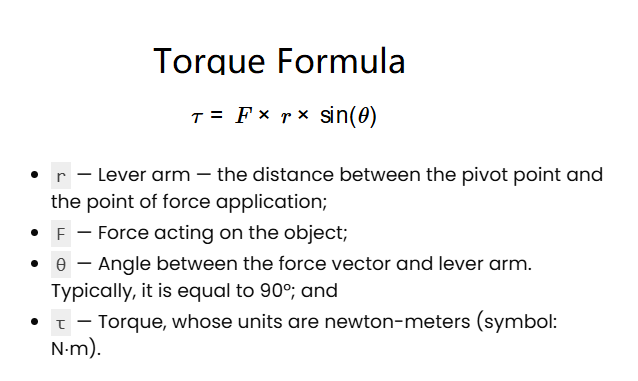1. What is a Force to Torque Calculator?
Definition: This calculator determines the torque, force, or lever arm length using the relationship between these variables, based on the formula τ = r × F × sin(θ).
Purpose: It is used in physics, engineering, and mechanical design to analyze rotational forces in systems like motors, bolts, and levers.
2. How Does the Calculator Work?
The calculator uses the following formula:
\[
\tau = r \times F \times \sin(\theta)
\]
Where:
- \(\tau\): Torque (N·m, lbf·ft)
- \(r\): Lever arm length (m, cm, ft, in)
- \(F\): Force (N, lbf)
- \(\theta\): Angle between force and lever arm (degrees)
Unit Conversions:
- Torque Units: N·m, lbf·ft (1 lbf·ft = 1.355818 N·m)
- Force Units: N, lbf (1 lbf = 4.44822 N)
- Length Units: m, cm, ft, in (1 m = 100 cm, 1 m = 0.3048 ft, 1 m = 39.3701 in)
Steps:
- Select the variable to calculate: Torque (τ), Force (F), or Lever Arm Length (r)
- Enter the known values, selecting units for torque, force, and length
- Enter the angle in degrees (default is 90°)
- Convert all inputs to SI units for calculation
- Calculate the unknown variable using the formula
- Select the desired unit for the result and view the converted value
3. Importance of Force to Torque Calculation
Calculating torque is essential for:
- Mechanical Design: Designing systems like engines, gears, and levers where rotational force is critical.
- Engineering Applications: Ensuring proper torque for bolts, motors, and other components.
- Performance Analysis: Optimizing the efficiency of rotating machinery.
4. Using the Calculator
Examples:
- Example 1 (Calculate τ): For a force \(F = 100 \, \text{N}\), lever arm \(r = 50 \, \text{cm}\), and angle \(\theta = 90^\circ\):
- Lever arm in m = \(50 \times 0.01 = 0.5 \, \text{m}\)
- Torque = \(r \times F \times \sin(\theta) = 0.5 \times 100 \times \sin(90^\circ) = 50.000 \, \text{N·m}\)
- In lbf·ft = \(50 \times 0.737562 = 36.878 \, \text{lbf·ft}\)
- Example 2 (Calculate F): For a torque \(\tau = 30 \, \text{N·m}\), lever arm \(r = 12 \, \text{in}\), and angle \(\theta = 90^\circ\):
- Lever arm in m = \(12 \times 0.0254 = 0.3048 \, \text{m}\)
- Force = \(\frac{\tau}{r \times \sin(\theta)} = \frac{30}{0.3048 \times \sin(90^\circ)} = 98.425 \, \text{N}\)
- In lbf = \(98.425 \times 0.224809 = 22.116 \, \text{lbf}\)
- Example 3 (Calculate r): For a torque \(\tau = 20 \, \text{lbf·ft}\), force \(F = 50 \, \text{lbf}\), and angle \(\theta = 60^\circ\):
- Torque in N·m = \(20 \times 1.355818 = 27.1164 \, \text{N·m}\)
- Force in N = \(50 \times 4.44822 = 222.411 \, \text{N}\)
- Lever arm = \(\frac{\tau}{F \times \sin(\theta)} = \frac{27.1164}{222.411 \times \sin(60^\circ)} = 0.141 \, \text{m}\)
- In cm = \(0.141 \times 100 = 14.100 \, \text{cm}\)
- In in = \(0.141 \times 39.3701 = 5.551 \, \text{in}\)
5. Frequently Asked Questions (FAQ)
Q: What is torque?
A: Torque is the rotational force that causes an object to rotate around an axis, calculated as \(\tau = r \times F \times \sin(\theta)\).
Q: Why is the angle important?
A: The angle determines the effectiveness of the force in producing torque. At 90°, the force is fully effective (\(\sin(90^\circ) = 1\)); at 0° or 180°, no torque is produced (\(\sin(0^\circ) = 0\)).
Q: What is the lever arm length?
A: The lever arm length is the perpendicular distance from the axis of rotation to the point where the force is applied.
Force to Torque Calculator© - All Rights Reserved 2025
 Home
Home
 Back
Back
